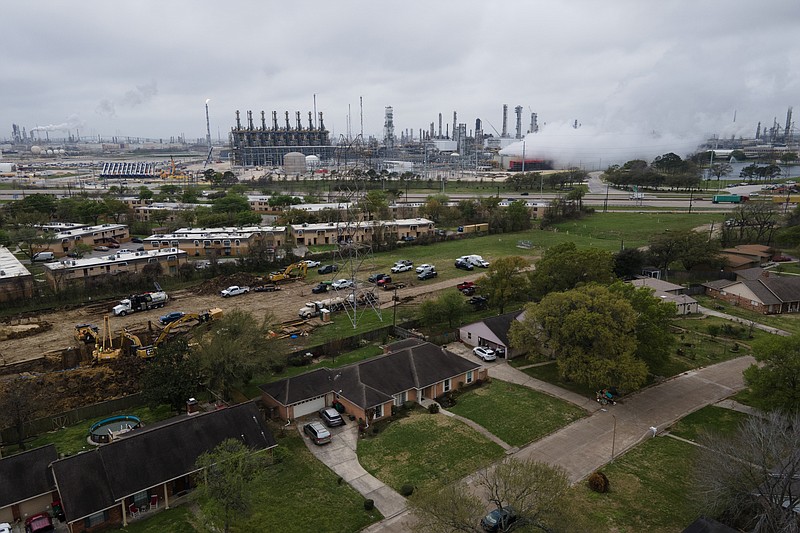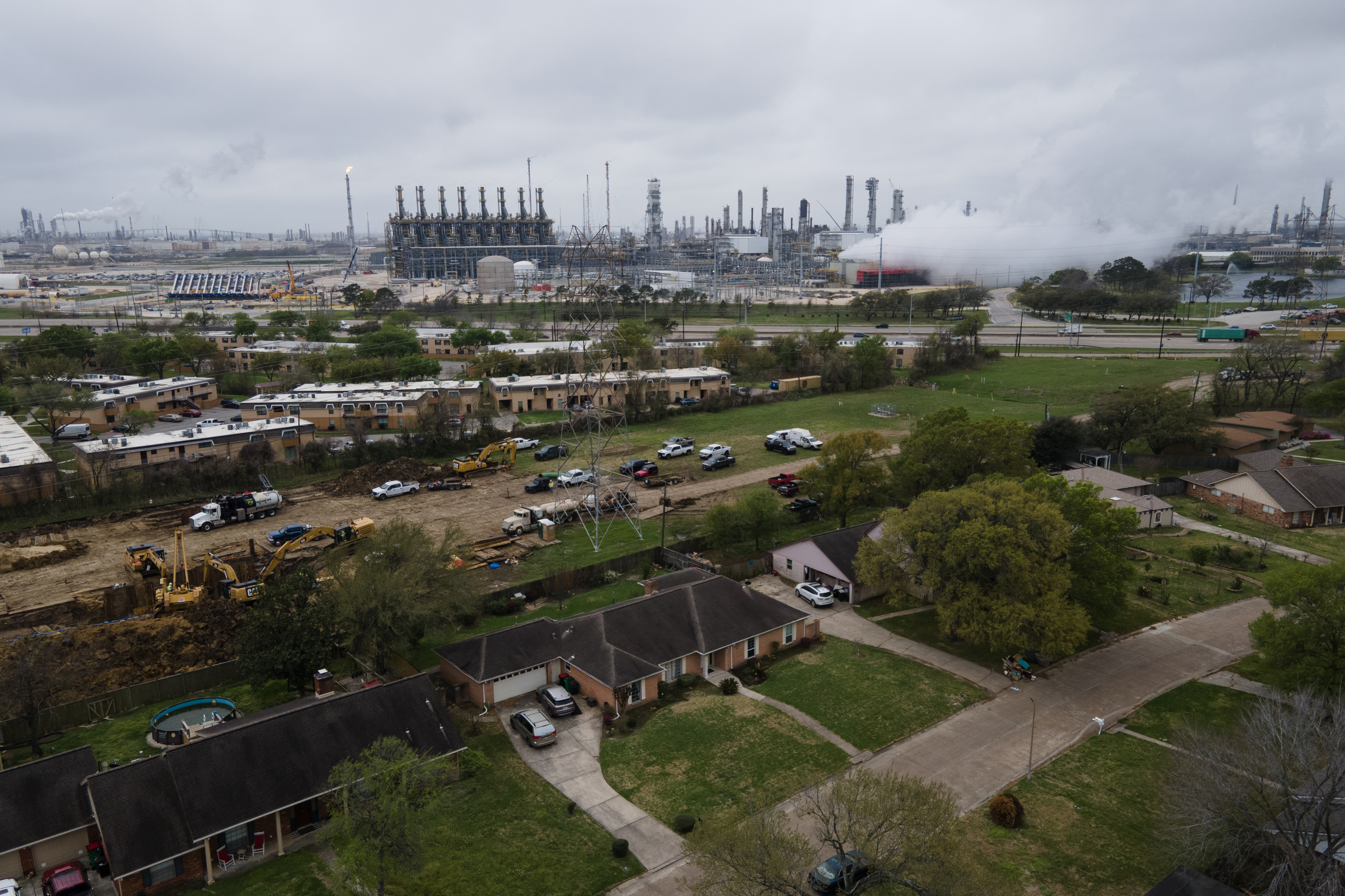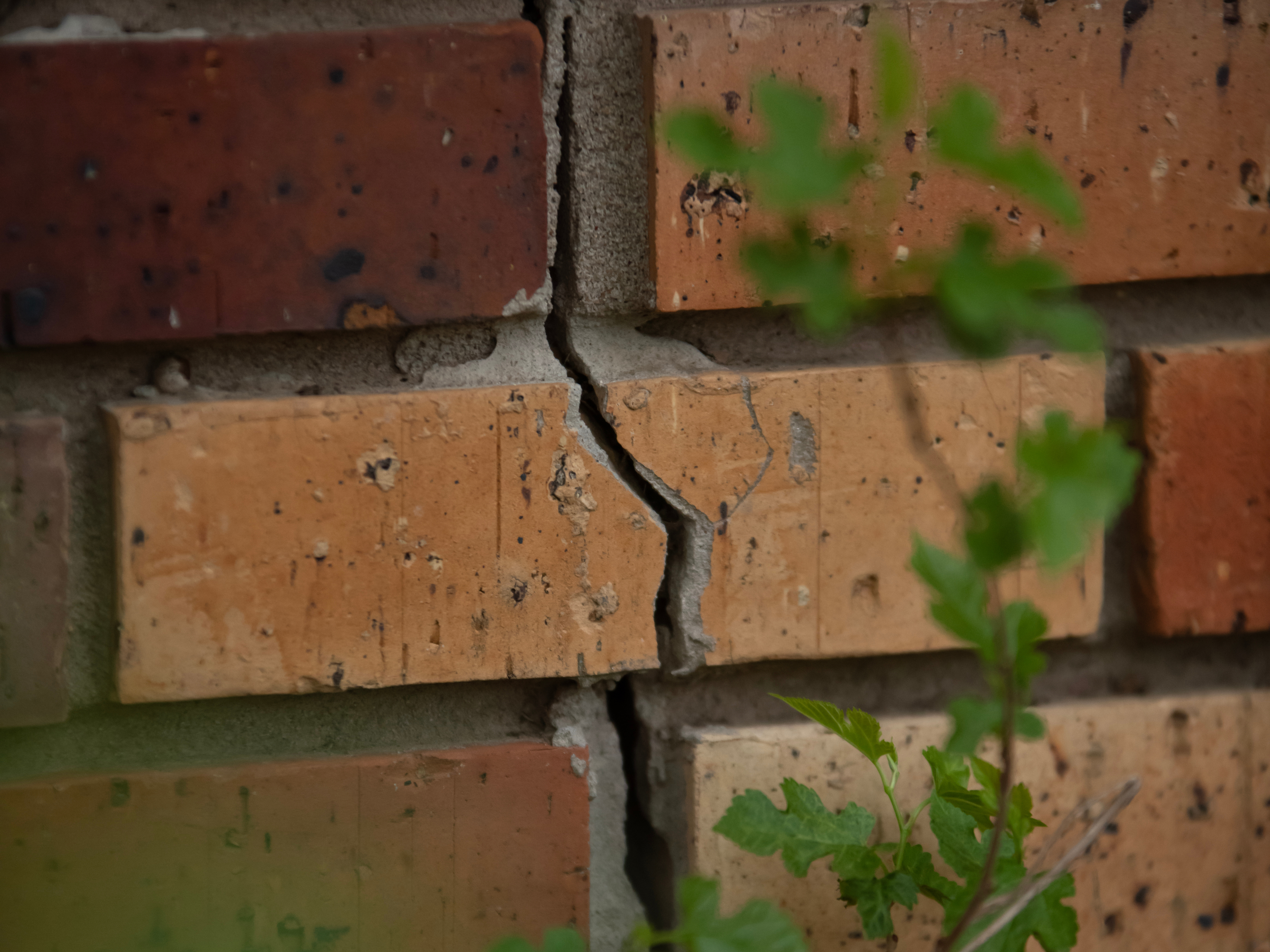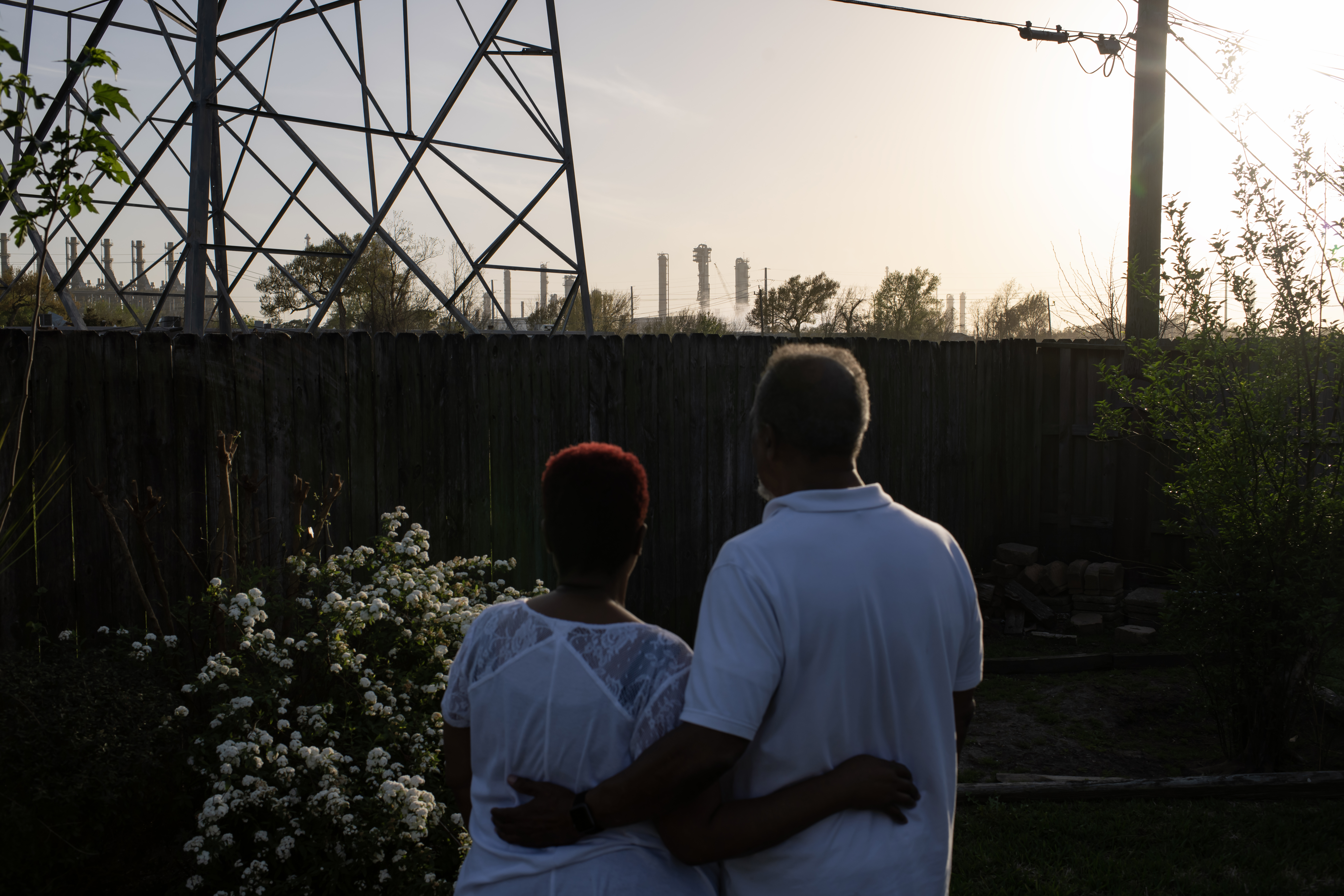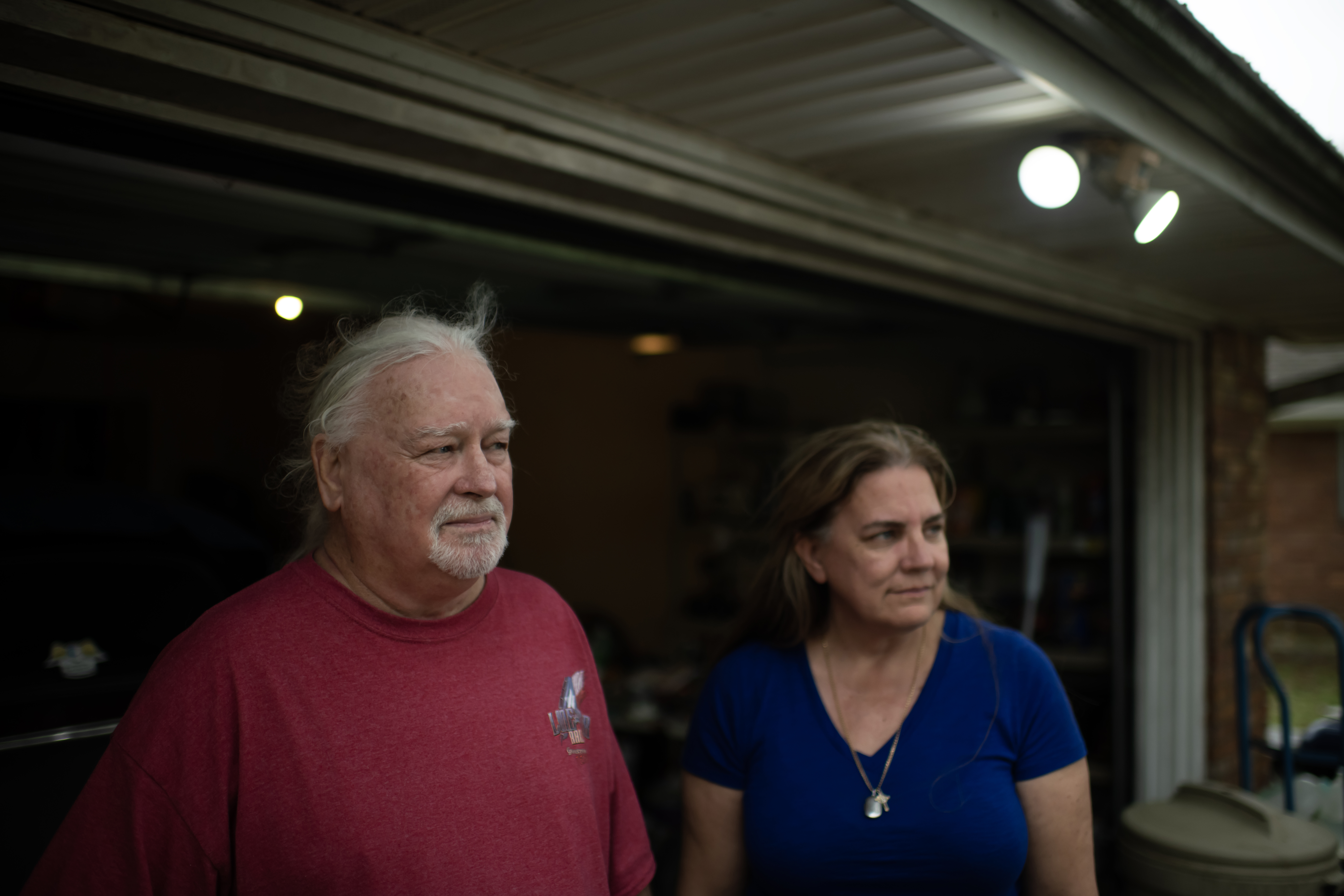BAYTOWN, Texas -- When Shirley Williams chose the brick ranch house in a quiet subdivision east of Houston 25 years ago, she picked it for the lush, peaceful backyard. She pictured her husband, Arthur, puttering around the garden, growing vegetables and caring for a row of citrus trees. This was their retirement plan.
Then their neighbor, ExxonMobil, intruded. The Williamses couldn't see the company's oil refinery and petrochemical complex when they bought their house in 1998, but it is impossible to ignore now. Eight towering furnaces, lined up like a formation of infantry soldiers, rise over their backyard fence. On good days, they belch white steam, but there are also days when the "dragons," as some neighbors call them, fill the sky with black smoke and flames.
In 2018, when the company started up its expanded petrochemical operation, the Williams' windows shook from the noise and cracks appeared in their ceiling, they said. Shirley retreated indoors; all but one of Arthur's fruit trees died, the couple said, and he stopped gardening.
"I used to tell Arthur: 'That monster is going to shake our house apart,'" Shirley said. "But I just figured we weren't big enough to fight Exxon."
For over a decade, Baytown residents and environmental groups have been trying to force Exxon to curb its air pollution and pay a fine for the thousands of days it reported violating its Clean Air Act permits. Exxon has fought them at every turn, dragging out a legal battle that began in 2010 and that shows no signs of ending. The company recently won another round in court -- a hearing that, activists say, could weaken ordinary Americans' ability to sue industrial polluters across the country.
In late February, the U.S. Court of Appeals for the 5th Circuit in New Orleans agreed to reconsider the case before an en banc panel of all 17 full-time judges. The decision vacated the original panel's 2-1 ruling upholding a $14 million penalty against the company for air pollution violations and granted Exxon a new hearing before one of the nation's most conservative courts.
"They explicitly argue that citizens should not be allowed to bring wide-ranging enforcement actions, that [this] usurps the role of the government, which betrays exactly what they're scared of: citizens taking action to enforce the law when government regulators don't," said Josh Kratka, a senior lawyer with the National Environmental Law Center and one of the attorneys representing plaintiffs in the case. "It serves as a warning to anyone who wants to sue Exxon for doing anything."
Exxon argues that the environmental groups behind the case, Environment Texas and the Sierra Club, have not proved that the plaintiffs -- people who either lived in Baytown or visited regularly -- were injured by each of the more than 16,000 air pollution violations the company reported between 2005 and 2013.
"Long-settled law requires that citizens who bring claims for relief under the Clean Air Act show that they were actually injured by an event occurring at an industrial facility," company spokesman Todd Spitler said in an email. "The law does not permit anyone, including environmental advocacy groups, to misuse the law in the way it has been misused in this case."
Like other large oil companies, Exxon earned a record profit in 2022, bringing in $55.7 billion. While a $14 million fine would not mean much to the company, a loss could prove enormously costly for Exxon in other ways, by encouraging a wave of similar lawsuits and damaging its ability to hold itself out as a good neighbor.
At roughly 3,400 acres, ExxonMobil's Baytown refinery complex is one of the nation's largest petroleum and petrochemical facilities -- and it has a history of excessive flaring, explosions and worker injuries. During a reporter's recent visit, chemical odors from the complex hung heavy in the air. The plant's emissions reports show that benzene and butadiene, chemicals linked to cancer, are among its pollutants.
Since the lawsuit was filed, Exxon has made changes to the Baytown refinery that have reduced its emissions and the company says it has spent roughly $1 billion on upgrades. Still, environmental advocates say this sprawling facility remains one of the worst polluters in the region, releasing chemical compounds that could pose long-term risks of cancer, asthma and other respiratory illnesses, even if the immediate exposure levels are not toxic.
Baytown is home to about 83,000 people and three major chemical manufacturing sites run by Chevron Phillips, Covestro and Exxon. Latino residents make up its largest ethnic group, at about 50 percent of the population, followed by White people, at about 30 percent. Roughly 1,000 people live within a mile of Exxon's Baytown complex and many more attend churches and schools that sit in the shadows of its smokestacks. Politically and economically, where the city ends and the giant industrial complex begins is a blur.
"The people in this area have bought into this false dichotomy that you have to choose between industry and health," said Shae Cottar, a real estate agent and one of the plaintiffs in the citizen suit against Exxon. When the lawsuit was filed in 2010, Cottar lived next to the Baytown complex in a mostly low-income development called Shady Hill Villa where, he said, loud noises and fumes coming from the plant regularly disturbed his sleep and gave him headaches.
"Myself and two of my kids all have asthma, so when those emissions events happened, we'd have to stay inside because it'd impact our breathing too much," Cottar said. He has since moved farther away from Exxon.
The Baytown refinery reported releasing more than 950 tons of pollutants in 2021 and 2022 combined, making it the second-highest emitting refinery in the Houston, Port Arthur and Texas City areas those years, according to a recent analysis by the Environmental Integrity Project advocacy group. Another ExxonMobil facility, the Beaumont refinery, ranks as No. 1.
The pollutants the Baytown refinery released included sulfur dioxide, carbon monoxide, butadiene and benzene. Though some contaminants were released during the refinery's normal operations, others came from sudden equipment breakdowns and leaks. These unanticipated, high-emission incidents happened 28 times in 2021 and 2022, during which the refinery reported releasing 550,000 pounds of sulfur dioxide and 2,719 pounds of benzene.
Baytonians living near the complex said the refinery flares, used to burn off excess gas, often happen in the middle of the night, or during periods of heavy rain or extraordinarily cold weather. When harsh winter storms hit Texas in February 2021 and again last December, knocking out power and interrupting natural gas supplies, some of the nation's largest refiners shut down, flaring gas to protect their equipment. Yet the Baytown refinery emitted more pollutants than most other facilities in the area -- hundreds of thousands of pounds more, according to the Environmental Integrity Project's analysis.
Although flaring is intended to minimize the release of toxic gases, some unburned pollutants escape into the air. In the Country Club Oaks neighborhood, where Mike Szumski lives, the flares shake his entire house, light up the sky and sound, he said, like a "747 is about to take off."
"There was one time here, they were flaring so much that it was like at 11 p.m. at night and you could stand in my driveway and read a newspaper by the light," Szumski said.
His wife, Terri Blackwood, who lives in her own home on the other side of the Baytown complex, said she has repeatedly asked the company to share more information with residents during flaring, but "Exxon just tells us everything is normal," she said.
Two serious fires have erupted in the complex in the past several years, injuring workers and sending plumes of black smoke into the sky. Despite these incidents and the more than two dozen air pollution violations the plant has reported over the past two years, there has been little enforcement.
Texas environmental regulators fined the company only five times, totaling $156,000, in 2021 and 2022 for the refinery's clean air violations. A state government review last year found the Texas Commission on Environmental Quality's leaders have become "reluctant regulators," its staff is spread thin and, rather than emphasizing enforcement, its policies "encourage industry members to self-govern and self-police." While President Biden has spotlighted the importance of protecting vulnerable communities from pollution, the Environmental Protection Agency's regional office, headquartered in Dallas, has not intervened.
A spokesperson for the Texas environmental regulator said the agency appreciates the review . "We welcomed the opportunity to take a fresh look at our processes to improve the way we do business," she said in an email.
Local officials say their hands are tied. Christian Menefee, the Harris County attorney, said that the Texas legislature has strangled his office's ability to hold industrial polluters to account. One such law, which Menefee referred to as the "mother-may-I bill," requires his office to seek permission from the Texas attorney general before suing a company over its emissions violations. The state has also intervened in lawsuits Harris County filed against Exxon over its Baytown pollution, settling for "pennies," Menefee said, or dropping them.
"The state has set up roadblock after roadblock," Menefee said. "If I'm driving and I break the law, I'm going to get pulled over and prosecuted. But in Texas, we've created a situation where industry can violate laws with impunity and there's nothing more than a slap on the wrist."
The heavy air pollution that burdens Harris County residents is well-documented. Despite overall air quality improvements since the late 1990s, and a push from community groups to install more monitors, the Houston metropolitan area ranks as one of the dirtiest in the country for ozone pollution, according to the American Lung Association. The region is thick with industrial facilities located right next to residential neighborhoods, disproportionately exposing Black and Latino people to higher concentrations of air pollutants.
"Texas is always reluctant to hold refineries and chemical plants accountable for their illegal pollution," said Eric Schaeffer, executive director of the Environmental Integrity Project. "Enforcement actions are few and far between."
Within Baytown, conversations about the Exxon complex's problems tend to devolve into personal attacks, said Agustin Loredo, a lifelong resident whose home in West Baytown looks out onto the refinery. Exxon is the city's largest employer and it spreads its donations among the local public schools and charities. In Loredo's view, this makes it difficult for residents to confront the pollution. "If you don't like it, you can leave" is a common rejoinder whenever Baytonians start to debate Exxon's presence, he said.
"Everyone is somehow linked to Exxon," Loredo said. His family has lived in the area since 1924, and his grandfather and great-grandfather worked at the plant. "I'm not against Exxon being there. But we have to hold them responsible. If I drive around in a car that's billowing out black smoke, you'd be like, 'Hey man, fix your car.'"
Over the years, Exxon has bought out property owners abutting its Baytown complex, knocking down homes to create a small buffer along parts of its perimeter. Some of the facility's neighbors are hopeful they might get a similar offer -- and are frustrated it hasn't happened yet.
Szumski said he has begged the company to buy him out of his home, which he said has been badly damaged by the plant's operations and has lost much of its value. But Exxon has shown no interest.
On the other side of the complex, Sharon Rogers said she has accepted the likelihood that Exxon may one day want to buy out her neighborhood, a cluster of upscale homes that sits on a narrow strip of land squeezed between the Exxon complex and the Houston Ship Channel, the hub of oil and gas production on the Gulf Coast of Texas.
When Rogers moved in 50 years ago, the land behind her development was densely wooded. Now, all that separates the Bay Villa homes and heavy industry is a two-lane road dominated by the company's truck traffic.
She recalls being "blown out of bed," she said, when a large fire broke out at the Baytown refinery in 2021. She keeps her purse and a pair of shoes next to her nightstand, in case another disaster at the complex forces her to flee in the middle of the night.
"I don't know what the solution is. I just want [Exxon] to do the right thing by everybody," Rogers said. "It's awful to have to always live in fear."

